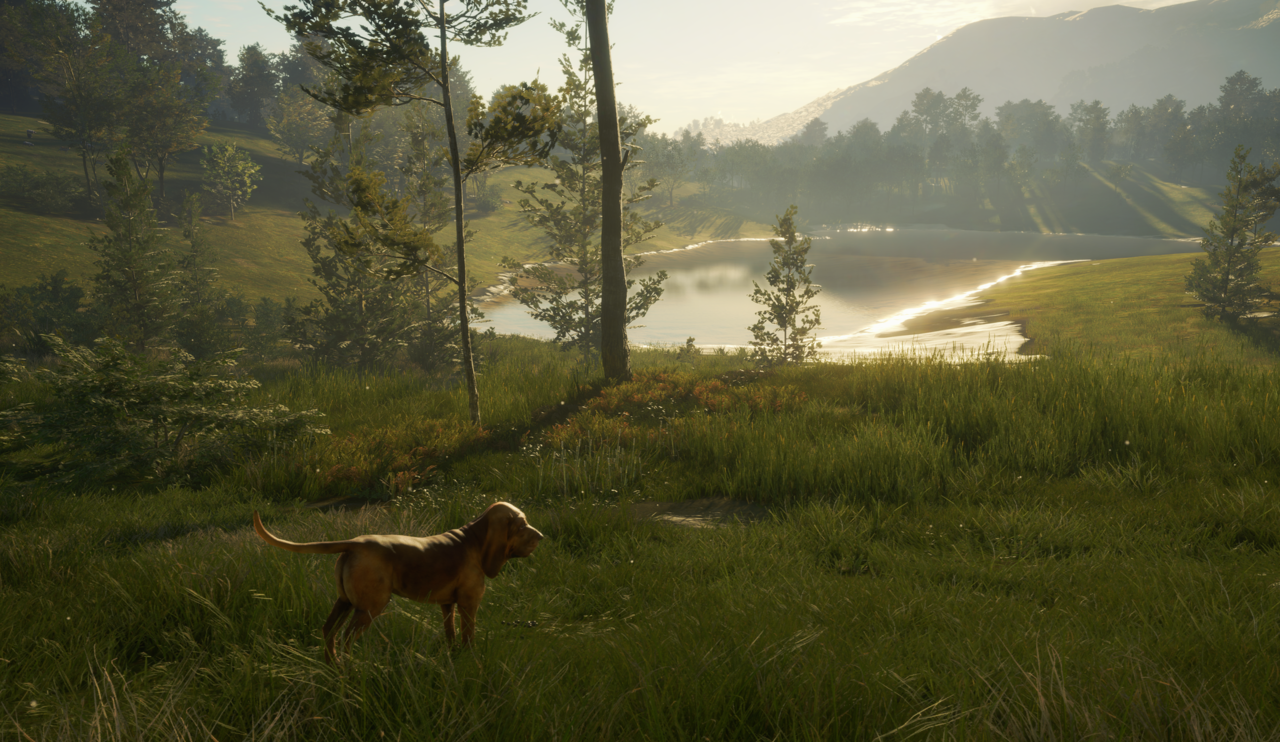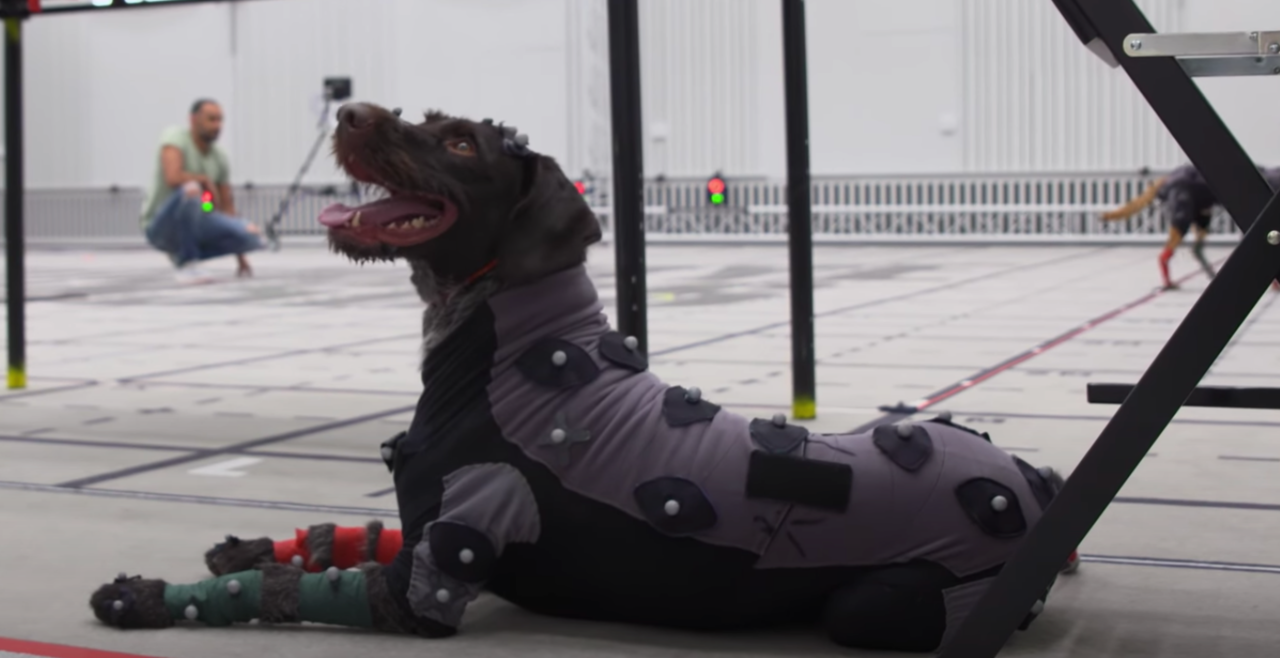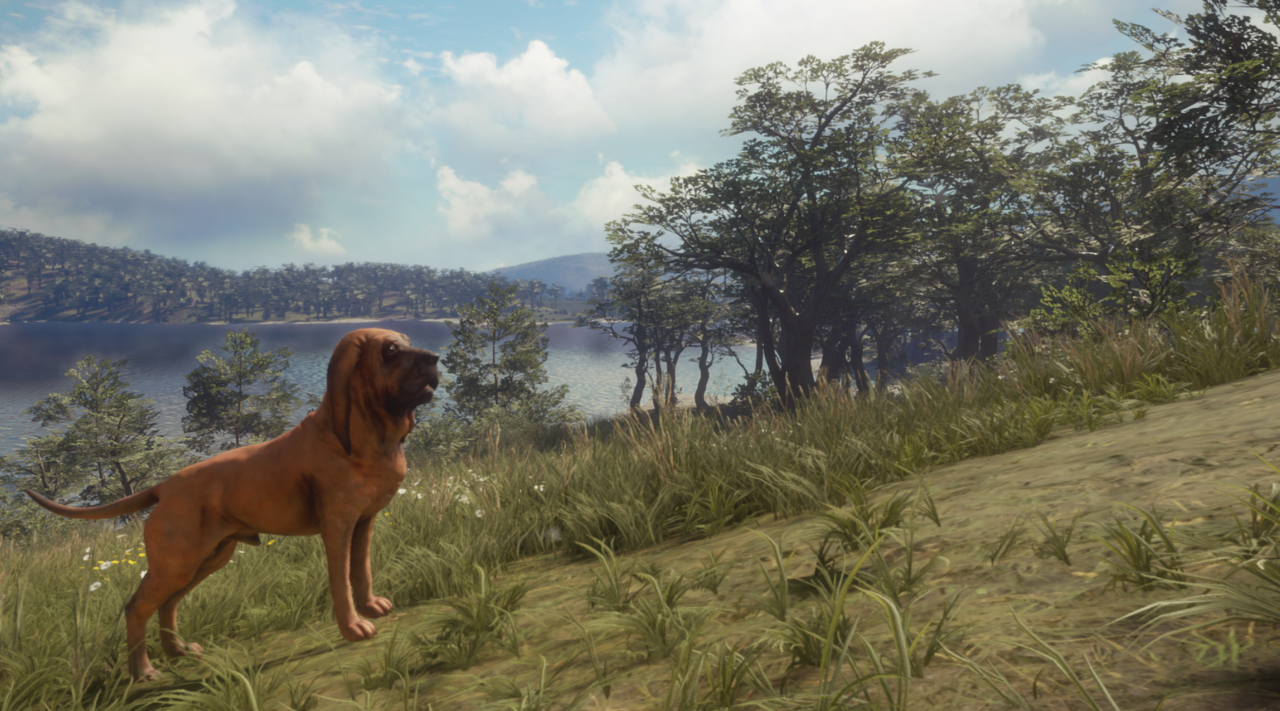The developers of theHunter: Call of the Wild recently introduced new DLC that brings a hunting dog to the game for the first time. Hunting dogs have been used for a very long time to track down animals and recover them, and for support and companionship in the field. The history of humans and dogs working together goes back thousands of years, in fact.
Dogs were one of the most-requested features from players, and now they're in the game as part of a $4 Bloodhound DLC pack for the PC and console hunting game, which has millions of players.
We recently had the chance to speak to developer Expansive Worlds about the Bloodhound DLC and more. Game designer Arshak Ardeshir explained to us where the idea came from, if the dog can die (a bleak question, we know), and if more dogs might come to the game in the future.
The bloodhound dog you see in theHunter moves and acts believably thanks to an extensive motion-capture process that saw the studio bringing in multiple dogs and strapping motion-capture suits on them to record their movements.
Dogs are known to be obedient if they are trained, but you still can't command them to act like you could with a human.
"The planning and execution of the motion capture was challenging, as unlike with human actors, you can't tell a dog to 'do that one more time, but stop on your left foot first please," Ardeshir said. "This made it difficult to predict how the moment-to-moment actions would go. Quite often though, we ended up getting things we needed in places where we didn't expect, and sometimes things that would seem simple just weren't happening."
With the Bloodhound at your side, the dog--which has 300 million scent receptors in its nose--can help you pick up lost blood trails, locate kills, and track prey even when they've stopped dropping blood. Additionally, the dog can help you determine when an animal is about to be spooked. Not only that, but having a canine companion by your side in the wilderness makes the solitude of nature more of a shared experience. The dogs in theHunter have 30 companion levels and 15 tracker levels, so the more time you spend hunting together, the more advanced a hunter you may become.
The Bloodhound DLC came to theHunter in late March and it's already proving to be popular, according to Ardeshir.
"Quite frankly, we're overwhelmed with all the positive feedback surrounding the first canine-companion in the game!" he said. "It has been a long-time request from our players, so it’s great to see people having so much fun. Our focus now is to continue to monitor feedback, and work on addressing any issues that players may experience."
You can check out GameSpot's full interview with Ardeshir below, in which he also talks about the challenges of using motion-capture for the dogs, what was most important in the studio's research for the dogs, and more about the resurgence in popularity of dogs in games.
"I'm glad that every cycle of digital dogs raises the bar even further in terms of how life-like and loving they can be in comparison to real dogs," Ardeshir said.
And just so we're clear up front--your little dog friend cannot die.
"No, the dog can't die," Ardeshir said. "Losing your dog forever would be too much of a loss, and if it was rendered incapacitated for a certain period of time, it would be a nuisance."
Phew.
theHunter: Call of the Wild is available now on console and PC. The Xbox edition is free with Xbox Game Pass.
For those just catching up, what is the Bloodhound DLC all about?
The Bloodhound is the first ever canine-companion in theHunter: Call of the Wild. It keeps players company on their hunts, and brings a wide selection of useful skills to the table, including being able to sense when an animal is about to be spooked, picking up blood trails, and locating harvests.
What was the inspiration for releasing this Bloodhound DLC and using real dogs for the motion capture? What convinced you to use real dogs instead of creating them entirely from scratch in the computer?
It’s important for us that theHunter: Call of the Wild delivers an immersive experience that is representative of the ‘great outdoors’; the beautiful nature, diverse wildlife, and joy of exploration. When our players visit one of the game’s reserves, we want them to feel as if they are really there.
This ethos is true also for the Bloodhound. We wanted to capture all the minute movements, actions, and behaviors a dog performs in day-to-day situations, and translate that into game animations. Motion capture is one of the best ways to achieve this. That said, there’s still a lot of work involved for our animators to make the recorded raw data usable in our engine.

What kinds of things can your dog do and help you with in the game?
The Bloodhound has several tricks up its paw. First of all, it's an awesome companion and someone to keep you company on long hunts. From a hunting perspective, there’s a great deal of benefits too; for example, it can sense when an animal is about to be spooked, help pick up lost blood trails, locate harvests, and even continue tracking prey that has stopped dropping visible blood clues.
What were some of the most important factors you wanted to get right when bringing the dog into the game?
Realistic movements, sound, and the look of the dog are super important factors in making the dog fun to interact with. The art and sound team worked hard on getting those areas to feel right. Companion-wise, we also focused on making the Bloodhound behave like a dog would when it’s not doing anything special. What it decides to do when you are not giving it commands is equally as important as how it executes specific commands.
In terms of game design, we focused extensively on the usability of the dog, both in terms of how you interact with it, what tasks it can do and how effective it is at performing those tasks. We realized quickly that in order for players to use the dog, and to keep using it over time, it needed to be unobtrusive, easy to use and helpful in situations where players of different skill might struggle.
What makes a virtual dog look and act realistic?
It’s a combination of having access to believable animation and tech that makes the dog more reactive to the player and environment (e.g. ‘look-at’ systems), and using the underlying AI systems to communicate with the game world and the animations systems in a smart way.

Can you walk us through the challenges of creating a digital dog and the work you did to make sure you got it right?
There are a lot of challenges, many of which are unique to the different disciplines in our team. In the end, communicating and ensuring that solutions synergize is what creates a good end result. While there are obvious overlaps, what makes our digital dog work is not the same as a dog in another game. It boils down to what our dog needs to do and what sentiment we are looking for in the player.
As game design spans multiple areas, one of the challenges we faced involved making the dog behave correctly in regards to its decision-making AI linked to what commands we want it to perform, while overlapping that with the dog's readability. We wanted there to be a clear line of communication between the player and the dog, so that both understand what the other is trying to do. Like is the case with many parts of game development, it’s about researching, creating a design, testing that design with players, and then adjusting and redesigning until you get the desired reaction.
What kind of research did you do for the game? What was most important?
Naturally, the dogs in our preceding title theHunter Classic served as an inspiration to help us learn what we could improve and streamline for theHunter: Call of the Wild. We researched how the Bloodhound is used in real-life hunting and tracking situations by reading books, watching video material, and more. Of course, we also looked into how other games have implemented canine-companions, both in terms of usability, movement and AI.
What were some of the challenges related to using motion-capture for the dogs? And how did you overcome them?
The planning and execution of the motion capture was challenging, as unlike with human actors, you can’t tell a dog to “do that one more time, but stop on your left foot first please”. This made it difficult to predict how the moment-to-moment actions would go. Quite often though, we ended up getting things we needed in places where we didn't expect, and sometimes things that would seem simple just weren’t happening.
This was also the first time we worked with motion captured animals, which was a fun challenge for the animation team, both from a technical and animation perspective. Motion capture requires a different approach than making hand-keyed animations, as it's more about subtly editing the data to make it do what you need while keeping the underlying motion intact.
"No, the dog can't die. We simply don’t think it adds enough gameplay value. Losing your dog forever would be too much of a loss" -- Ardeshir
The most interesting challenge was probably creating the dog-to-player interactions. It’s something we hadn’t done before, so there were many technical hurdles regarding aligning and syncing up multiple characters. The dogs we motion captured were also much smaller than the dog in our engine, which made the re-aligning process more interesting. In the end, I think it worked out well.
Sorry for the dark question, but... can the dog die?
No, the dog can't die. We simply don’t think it adds enough gameplay value. Losing your dog forever would be too much of a loss, and if it was rendered incapacitated for a certain period of time, it would be a nuisance. To combat that, there would have to be layers of information and control to help the dog avoid threats, which we felt was a player-facing task that was not desirable. But who knows, our approach to this might change over time.
Can you speak to the feeling of companionship that having the pup by your side makes you feel in the game?
There is a natural bond between humans and dogs, which I can only imagine stems from our shared 10,000 year history of friendship and co-dependence. Our goal was to make sure we did that history justice by bringing a dog to life that feels right for our game and our players.
There has been a mini resurgence of dogs in video games lately across a number of titles--what’s your take on that?
Like in most other fields, trends in games have a cyclical nature. The timing of this DLC was more closely tied to what we felt the players wanted and our plans for how we want theHunter: Call of the Wild to develop into the future. I'm glad that every cycle of digital dogs raises the bar even further in terms of how life-like and loving they can be in comparison to real dogs.

Now that the dog DLC has been out for a little while, what are you hearing from fans about it?
Quite frankly, we’re overwhelmed with all the positive feedback surrounding the first canine-companion in the game! It has been a long-time request from our players, so it’s great to see people having so much fun. Our focus now is to continue to monitor feedback, and work on addressing any issues that players may experience.
Do you have plans to introduce any further canine companions in the future?
While I can't speak about concrete plans, we’re always thinking and evaluating how we can evolve and improve the game to meet and surprise player expectations. We’re lucky to have a very passionate community, which helps us gauge what content to focus on moving forward.

